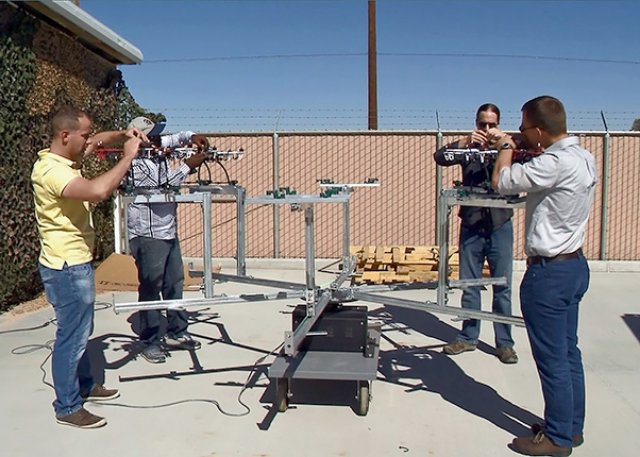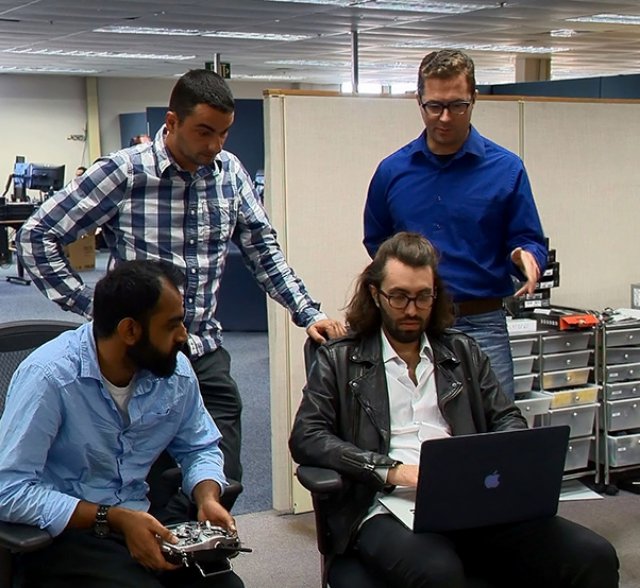
Two Naval Air Warfare Center Weapons Division teams, Urban Reconnaissance and Situational Awareness (URSA) at Point Mugu, Calif., and Swarm View at China Lake, Calif., have wrapped up their projects for the Naval Air Systems Command’s second annual Innovation Challenge.
With six months to work and a budget of $25,000 to spend on materials, the teams presented two unmanned aerial vehicle-focused projects designed to help the warfighter see what they otherwise could not and give the warfighter the opportunity to focus his attention elsewhere.
Point Mugu’s URSA team worked to reduce or entirely eliminate urban combat casualties using an unmanned aerial vehicle armed with a camera to gain situational awareness in GPS-denied environments. The UAV would then use advanced algorithms to provide the user with a high resolution, 3D Virtual Reality map in real-time. URSA team members were Michael McConnehey, Christopher Gudea, Shivneil Prasad, Georgi Ivanov, Cory Eighan, and Christopher Smith.
“Innovation is really just pushing the envelope and trying to do new things in new ways,” said Michael McConnehey of the URSA team. “Sometimes, it’s taking something that feels old and familiar, repackaging it and retooling it for a completely new use. The Innovation Challenge presented an opportunity to try some of our ideas that hadn’t been fully funded and we saw a problem that we thought that we could offer an innovative solution to.”
China Lake’s Swarm View team built a UAV platform to simulate autonomous swarm coordination using a mesh network to perform object registration within the platforms’ environment. The swarm of UAVs equipped with cameras enables the warfighter to review updated images containing objects of interest and provide information about the distance to that object despite the sensors and the object of interest being in motion in a cluttered environment. Swarm View team members were Jeremy Siedschlag, Melvin Deberry, Joshua Elroy, Christopher Yelton, Clayven Anderson and Nicholas LeBlanc.
“The main benefit is a hyper-agnostic sensor suite that allows the warfighter to focus their attention on something else while the swarm looks around a predefined area,” Siedschlag said. “Ideally, there would be one operator and six drones allowing the user to make better use of their time since a lot money is spent on labor.”
Despite the challenges each team faced such as losing team members, having to change methodology halfway through along with various fabrication and technical issues, both teams took their setbacks in stride and ultimately gained experience in project management, navigating the procurement process and exposure to working with a diverse team.

Naval Air Warfare Center Weapons Division Urban Reconnaissance and Situational Awareness teammates, from left, Shivneil Prasad, Georgi Ivanov, Christopher Gudea and Michael McConnehey test out the capabilities of the software and controller they used for their Innovation Challenge on Oct. 19 at Point Mugu, Calif.
“From this project, I learned the importance of getting to know who your teammates are and learning whose attributes are best in what areas,” said Melvin Deberry of Swarm View. “You have to learn, especially at NAWCWD, how to embrace somebody else’s knowledge and do so respectfully. When you have an end goal, something that motivates you, there’s nothing you can’t do when everybody comes together as one.”
“Take a lot of risks, fail fast and fail early,” Gudea suggested for future participants. “When we did our project, we tried several different cameras, onboard processors and frame sizes and ended up getting rid of a lot of them immediately because they didn’t work for us. Be willing to take risks and be willing to fail. The hard part is knowing when you should quit on the areas that are failing, but the challenges are what make you better in your craft.”
Top Photo: Naval Air Warfare Center Weapons Division Swarm View teammates Joshua Elroy, front left, Melvin DeBerry, back left, Christopher Yelton, back right, and Jeremy Siedschlag, front right, work on the unmanned aerial vehicles used for their Innovation Challenge on Oct. 18 at China Lake, Calif.
Source: Aerotech News
